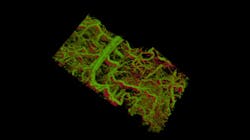Gold has long been used in dentistry because of its special mix of biosafety and physical attributes. More recently, it has facilitated medical research at a much smaller scale.
As a paper about cancer research explains, “Due to strong electric fields at the surface, the absorption and scattering of electromagnetic radiation by noble metal nanoparticles are strongly enhanced. These unique properties provide the potential of designing novel optically active reagents for simultaneous molecular imaging and photothermal cancer therapy….”1
Gold nanorods (GNRs) coated with poly(styrenesulfonate) (PSS) through a multistage process were conjugated with anti-epidermal growth factor receptor (EGFR) monoclonal antibodies. EGFR, as the name implies, controls cell multiplication, and when cell growth becomes unregulated, EGFR often is implicated. In an experiment, separate cultures of HaCaT nonmalignant cells and two types of malignant cells, HOC 313 clone 8 and HSC 3, were prepared. About twice as many nanorods were attracted to the cancer cells as were found on the normal cells. The higher concentration was caused by the anti-EGFR-to-EGFR binding that occurred on the surface of the cancer cells.
Courtesy of the de la Zerda Lab, Stanford University
Because of the binding, the GNRs scattered light differently than free nanorods or nanorods associated with normal cells, providing an optical means of distinguishing certain types of cancer cells. Also, because twice as many GNRs were attached to cancer cells, more heat from laser light would be absorbed by those cells than by normal cells. This means that cancer cells could be destroyed without harming normal cells.
A GNR’s surface plasmon absorption spectrum is directly related to its aspect ratio. This is important because near-infrared (NIR) radiation (650-900 nm wavelength) is not absorbed by tissue as much as other wavelengths, so cancer cells at greater depths can be reached. According to Reference 1, “By changing the shape of gold nanoparticles to GNRs, one cannot only change the absorption and scattering wavelength from visible to the NIR region, but also increase their absorption and scattering cross sections.”
Synthesis
The approach used in Reference 1 to generate GNRs with dimensions approximately 50-nm long x 15-nm wide is based on a seed-mediated growth method that uses auric acid and cetyltrimethylammonium bromide (CTAB). In a paper2 describing current work, GMRs about 4x as large—100 nm x 30 nm—have been synthesized using CTAB and gold chloride trihydrate as the main ingredients. Because the aspect ratio remains similar, the peak resonance at 815 nm is close to that observed in Reference 1 for the small GNRs. The important advantage of the large GNRs (LGNRs), also PSS-coated, is “… 110-fold greater spectral signal per particle than conventional GNRs, which enables detection of individual LGNRs in water and concentrations as low as 250 pM in the circulation of living mice.”2
Optical coherence tomography
LGNRs have been developed in a research program at Stanford University that improves “… imaging of living tissue at cell-scale resolution.”2 Although conventional GNRs allow cells to be optically identified, the GNRs absorb most of the light and scatter relatively little. Optical coherence tomography (OCT) depends on optical backscattering or back-reflection, and the LGNRs produce about a 13x greater OCT signal than GNRs, based on an equivalent amount of gold. The “110-fold” factor results from combining the 13x improvement with new post-processing algorithms.
As Reference 2 describes, “We developed custom processing algorithms … to divide raw [spectral domain]-OCT interferograms into two spectrally-distinct subsets … [corresponding] roughly to wavelength ranges of 900-1,000 nm and 800-900 nm.” Through further data manipulation, unwanted effects caused by “dispersion, chromatic aberrations from optics and signal processing, and absorption” have been minimized.
The overall imaging technique has been dubbed MOZART for Molecular imaging and characterization of tissue noninvasively At cellular ResoluTion. As a Stanford article3 explains, “The [researchers] … tested their technology in the ear of a living mouse, where they were able to watch as the nanorods were taken up into the lymph system and transported through a network of valves. They were able to distinguish between two different size nanorods that resonated at different wavelengths in separate lymph vessels, and they could distinguish between those two [types of] nanorods in the lymph system and the blood vessels. In one study, they could watch individual valves within the lymph vessels open and close to control the flow of fluid in a single direction.”
The article concludes with a projection that the next step for MOZART is to show that LGNRs can bind to specific kinds of cells so that the way cancer progresses at an early stage can be observed. Reference 1 appears to give relevant background information for the future research.
References
- Huang, X., et al, “Cancer Cell Imaging and Photothermal Therapy in the Near-Infrared Region by Using Gold Nanorods,” Journal of the American Chemical Society, 2006, Vol. 128, Issue 6, pp. 2115-2120.
- Liba, O., et al, “Contrast-enhanced optical coherence tomography with picomolar sensitivity for functional in vivo imaging,” Scientific Reports, Nature Communications, March 18, 2016.
- Adams, A., “Stanford scientists develop new technique for imaging cells and tissues under the skin,” Stanford News Service, March 18, 2016.
About the Author


